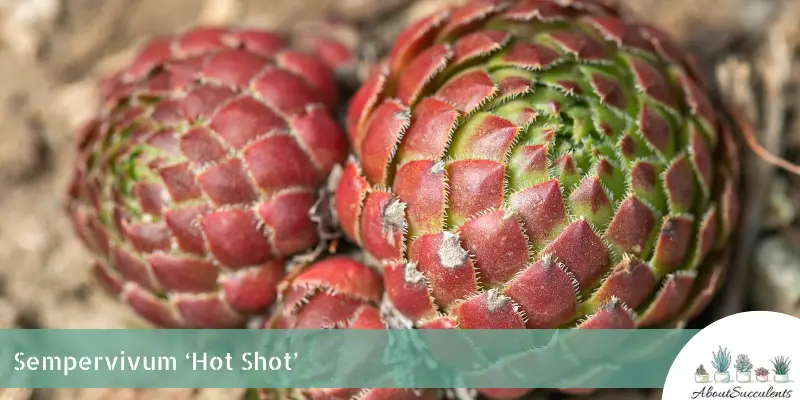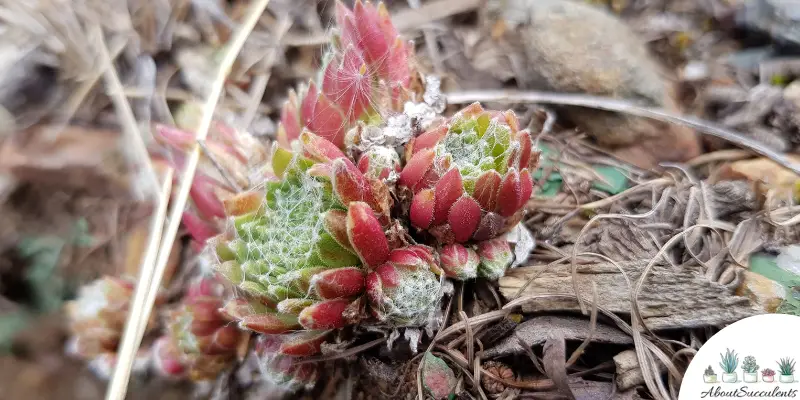
Sempervivum “Hot Shot” is an elegant-looking succulent that will surely grace any outdoor garden and space inside the home. The evergreen perennial is distinguished by having maroon-colored, fleshy, and fuzzy leaves that form a tight, compact rosette with a green center.
Hot Shot will produce charming small, star-shaped flowers that have pink colors in the summer. However, Sempervivum is a monocarpic succulent which means it will die after it blooms.
The good thing is that Hot Shot will also produce several offsets that you can use for propagation and grow more of this eye-catching succulent. As fast as a grower as Hot Shot is, at full maturity, it won’t grow taller than 3-inches (7.6cm) and 4-inches (10cm) wide.
Typical of succulents that produce offsets, Hot Shot is also commonly referred to as Hens and Chicks and Houseleeks.
Sempervivum Hot Shot is native to the United States and was hybridized by Kevin C. Vaughn from Sempervivum Marietta and Sempervivum Denise’s Cobweb. Hens and Chicks is a member of the Crassulaceae family.
General Information
Also known as: Hot Shot, Hens and Chicks, and Houseleeks.
Plant Family: Crassulaceae
Origin: The United States of America; hybridized by Kevin C. Vaughn from Sempervivum Marietta and Sempervivum Denise’s Cobweb.
Height: 3-inches (7.6cm)
Exposure: 6 hours of partial to full sun; avoid the afternoon sun
Water Needs: Drought-tolerant; only water the soil when it’s completely dry.
Soil Type: Cactus mix, sandy soil, succulent soil, or a blend consisting of 2 parts potting soil mixed with 1 part 50% perlite, pumice, coarse sand, and lava rock to speed up soil drainage.
Soil pH: 6.6 to 7.5
How to Grow and Care for Sempervivum “Hot Shot”

Are you worried that growing succulents in your backyard is a lost cause because your region experiences frosty weather? If so, you have nothing to worry about with Sempervivum Hot Shot.
This is a cold-hardy succulent that won’t mind being buried under a blanket of snow. Houseleeks can handle temperatures as low as -30°F (-34.4°C) and they will maintain their sublime colors throughout the winter season.
Whether you live in a temperate or frosty zone, you won’t have a hard time growing and caring for Sempervivum Hot Shot.
Sunlight
Sempervivum Hot Shot must get up to 6 hours of sunlight every day. It will appreciate the partial or full sun as long as they aren’t of the afternoon rays variety. The mid-day sun can be scorching hot and will burn the magnificent leaves of Sempervivum.
As an outdoor succulent, plant Hot Shot in a location that gets the required amount of sunlight. If the area is exposed to the afternoon sun, plant Hens and Chicks in partial shade.
Sunlight becomes more important when Houseleeks is raised as a houseplant. You have to situate the pot near a window that filters in up to 6 hours of sunlight per day. If this isn’t possible – particularly during winter – place the succulent under a Grow Light.
Watering
Be generous with sunshine but go easy with the water when growing and caring for Sempervivum Hot Shot. 6 hours of sunlight every day will keep Hens and Chicks healthy but water should only be given sparingly. To be precise, water only when the soil is 100% dry.
In the spring and summer months which are the growing seasons, the soil will dry out faster and you might water the soil every seven to 10 days. In contrast, the soil will retain moisture faster when it’s winter, so you’ll probably water only once every month.
If you give the soil water while it’s still wet or contains some moisture, the roots will rot and expose the plant to fungal infection.
To know that it’s safe to give water, stick your finger inside the soil. If the soil feels dry, then give it a drenching. You can also insert a stick and if its end feels dry after you pull out, go ahead and water the soil.
Pot and Soil
Sure that glass pot might look classy but in a few weeks, it might kill Sempervivum Hot Shot. The ideal pot for Houseleek is one that’s made of either unglazed ceramic or terracotta. These materials are highly absorbent and will dry out the soil faster. Glass pots won’t.
The right pot size for Hot Shot is one that’s slightly bigger than its base to enable the roots to grow without getting tangled up. Finally, make sure the bottom of the pot has a drain hole to filter out excess water from the soil.
Drainage must also be your priority when it comes to choosing the ideal soil for Hot Shot. Among your best choices are cactus soil, sandy soil, and succulent soil. You can also make your own blend of 2 parts potting soil mixed with 1 part gritty materials like perlite, pumice, coarse sand, and lava rocks.
Fertilizer is recommended if you’re growing Houseleeks indoors in order to improve the quality of the soil. Use organic fertilizer that has low nitrogen content and dilute it down to only 25% of its original strength. Fertilize the soil only once per month during the growing season.
How to Propagate Sempervivum “Hot Shot”
Sempervivum Hot Shot produces offsets that grow out of the rosettes. Not all offsets are ideal for propagation. Choose offsets that are bigger or approximately one-fifth the size of the plant because these are mature enough to have developed root systems.
Offsets Method
Step 1: Get a sharp knife and sanitize it with 70% isopropyl alcohol. Free up the offset by cutting around the area taking care that the roots remain intact.
Step 2: Allow the offsets to dry out and grow hard calluses over a period of 2 to 4 days.
Step 3: Plant the calloused offsets in well-draining succulent soil.
Step 4: Lightly water the soil and place the container in an area that gets up to 6 hours of partial sunlight every day.
Step 5: Once the roots have settled firmly in the soil, give it water only when the soil has completely dried out.
Frequently Asked Questions
Is Sempervivum “Hot Shot” Toxic to Cats and Dogs?
Sempervivum Hot Shot doesn’t appear on the list of plants that are toxic to cats and dogs found on the website of the American Society for the Prevention of Cruelty to Animals (ASPCA).
However, it doesn’t mean that your pet won’t experience intestinal distress after nibbling on Houseleek’s leaf. If you notice your pet feeling unwell, bring the animal to the veterinarian right away.
Why Is My Sempervivum “Hot Shot” Dying?
If you notice your Sempervivum Hot Shot not looking so hot; possibly sick and dying, the plant could be contaminated by a fungus that got in because the roots rotted away from overwatering.
Another cause of Hens and Chicks dying is that it’s been drained of nutritious sap and its leaves were contaminated by pests such as mealybugs, aphids, and scale insects.
Overwatering
Discoloration and the appearance of mushy-looking leaves are sure signs of root rot due to overwatering. If you notice yellow-brownish spots on the leaves that means bacteria has gotten inside of your succulent and is making its way out.
Grab a pair of garden shears or a sharp knife. Sterilize the cutting tool with 70% isopropyl alcohol and remove all of the infected sections. Wipe the rest of the plant with a mild, diluted fungicide.
Next, remove the plant from the soil and cut off all of the rotten roots. Let the plant dry out for 1 to 2 days.
In the meantime, get a new pot for Houseleeks and fill it with fresh sandy or cactus soil. Replant Hens and Chicks but don’t water the soil for 2 to 3 days more.
Pest Infestation
If you see white, cotton-like substances that have a waxy texture on the leaves, wipe them with a cotton ball soaked in 70% isopropyl alcohol. These substances are by-products of pests and can contaminate Hot Shot.
To keep these sap-sucking and leaf-eating pests away from Hens and Chicks, spray it with diluted neem oil and remove any leaves that have fallen off the main plant.
Yes. Monocarpic succulent Sempervivum Hot Shot will produce charming small, star-shaped flowers that have pink colors in the summer before it dies.
Last Updated on June 15, 2022 by Sofia Lara